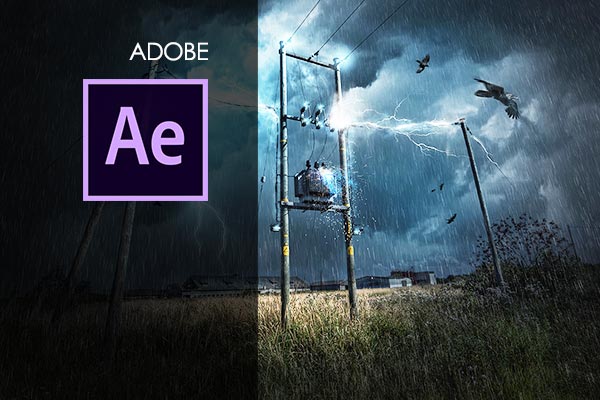Adobe After Effects
In this course you will learn to animate, alter, and composite media through the use of various tools and special plugins. After Effects is the industry-standard software for motion-graphics pros, web designers and visual effect artists for video editing. Both beginners and intermediate users will benefit from this course.
Included In This Course



Closed Captions



Certificate of Completion
After Effects is a Motion Media, Compositing, Animation, and Special Effects software. It can be complicated to use, but once you get the hang of it it’s very powerful.
Don’t have Adobe software? No problems. Adobe offers free trials of their most popular software. Simply visit Adobe to download a copy today.
Key Term Knowledge Base: Key Terms Related to Adobe After Effects
Adobe After Effects is a powerful tool used for creating motion graphics and visual effects in video production. Understanding key terms associated with this software is crucial for anyone looking to master or work effectively with After Effects. These terms will help you navigate the interface, understand tutorials, and communicate your ideas more effectively with others in the field.
| Term | Definition |
|---|---|
| After Effects | A digital visual effects, motion graphics, and compositing application used in the post-production process of film making, video games, and television production. |
| Composition (Comp) | The main working space in After Effects where media elements are combined and animations are created. |
| Layer | An individual element in a composition, which can be text, video, images, or solid color. |
| Keyframe | A frame where a new value is assigned to a property, creating a point of change in animation. |
| Timeline | The part of the interface where layers and their properties are animated over time. |
| Pre-Composing | The process of nesting a composition within another composition to manage complex animations more efficiently. |
| 3D Layer | A layer that exists in three-dimensional space, allowing for movement and animation along the X, Y, and Z axes. |
| Effect | A digital effect that can be applied to a layer to create various visual alterations. |
| Mask | A tool used to hide or reveal parts of a layer. |
| Parenting | A technique to link layers so that the child layer follows the transformations of the parent layer. |
| Puppet Tool | A tool used for adding deformable mesh to images or shapes for complex animations. |
| Rendering | The process of creating the final output of your composition for playback or export. |
| Anchor Point | The point around which layers rotate or scale. |
| Opacity | The transparency level of a layer. |
| Motion Blur | A visual effect that simulates the blur or streaking seen in fast-moving objects. |
| Shape Layer | A vector-based layer that can be used to create geometric shapes within a composition. |
| Text Layer | A layer used specifically for adding text to compositions. |
| Adjustment Layer | A layer that applies effects to all layers below it in the composition. |
| Expressions | A line of code used to create dynamic relationships between layer properties. |
| Plugin | An add-on software that expands the capabilities of After Effects. |
| Frame Rate (fps) | The number of frames displayed per second in a video. |
| Resolution | The number of pixels in each dimension that can be displayed. |
| RAM Preview | A preview method in After Effects for playing back animation smoothly by preloading frames into RAM. |
| Rotoscoping | The process of manually altering film or video footage one frame at a time. |
| Track Matte | A layer that controls the visibility of another layer. |
| Null Object | An invisible layer that can be used to control the animation of other layers. |
| Particle System | A type of effect used to simulate fuzzy phenomena like smoke, sparks, or dust. |
| Vector Graphics | Graphics based on mathematical equations, allowing for scalability without loss of resolution. |
| Alpha Channel | A channel that represents the transparency level of an image. |
| Bezier Curve | A curve defined by mathematical equations, used in motion paths and shape creation. |
| Chroma Keying | The process of removing a specific color (usually green or blue) from a video to overlay another image or video. |
| Color Correction | The process of altering and enhancing the color of a video. |
| Time Remapping | A technique for changing the speed of a clip, including reversing it or slowing it down. |
| Dynamic Link | A feature that allows seamless integration between After Effects and other Adobe software like Premiere Pro. |
| Graph Editor | A tool used to visually edit the speed and value changes over time for any animatable property. |
| Motion Tracking | The process of tracking the movement of an object within footage. |
| Z-Depth | A term referring to the third dimension in 3D space, used in positioning and animating layers. |
| Blend Modes | Modes that determine how a layer visually interacts with the layers beneath it. |
| Footage | Any video, image, or audio file imported into After Effects for use in a composition. |
| Workspace | The arrangement of panels and frames in the After Effects interface. |
| Bounce Expression | An expression in After Effects used to create a bouncing effect for an animated object. |
| Ease and Wizz | A script used for creating more natural and sophisticated animation interpolations. |
| Timecode | A sequence of numeric codes generated at regular intervals by a timing synchronization system, used for synchronization and identification. |
Knowing these terms will not only enhance your understanding of After Effects but also equip you with the language needed to explore its vast capabilities. Whether you’re a beginner or an experienced user, these terms are fundamental to mastering the art of digital animation and visual effects.
Blogs of Interest Related to This Course
Proudly DisplayYour Achievement
Upon completion of your training, you’ll receive a personalized certificate of completion to help validate to others your new skills.
Adobe After Effects - Legacy Course Content
Module 1: Introduction to After Effects
- 1.1 Introduction
- 1.2 What is After Effects?
- 1.3 Creating a New Project in After Effects
- 1.4 Creating and Animating Primitive Shapes Demo - Part1
- 1.5 Creating and Animating Primitive Shapes Demo -Part2
- 1.6 Simply Bouncing Ball Demo -Part1
- 1.7 Simply Bouncy Ball Demo - Part2
- 1.8 Complex Bouncy Ball Demo - Part1
- 1.9 Complex Bouncing Ball Demo - Part2
- 1.10 Exporting from After Effects
- 1.11 Curves Editor Demo
- 1.12 Importing Footage - Part1
- 1.13 Importing Footage - Part2
- 1.14 Parenting - Part1
- 1.15 Parenting - Part2
Module 2: Intermediate Effects and Techniques in After Effects
- 2.1 3D Layers and Cameras Demo - Part1
- 2.2 3D Layers and Cameras Demo - Part2
- 2.3 Animating Text Demo - Part1
- 2.4 Animating Text Demo - Part2
- 2.5 Animating Text Demo - Part3
- 2.6 Animating Text Demo - Part4
- 2.7 Importing and Syncing Audio
- 2.8 Particles Demo - Part1
- 2.9 Particles Demo - Part2
- 2.10 Lights Demo
- 2.11 Common Effects in After Effects
Module 3: More Advanced Effects and Techniques in After Effects
- 3.1 Puppet Building Demo - Part1
- 3.2 Puppet Building Demo - Part2
- 3.3 Puppet Building Demo - Part3
| 5 star | 82 | 82% |
| 4 star | 17 | 17% |
| 3 star | 1 | 1% |
| 2 star | 0% | |
| 1 star | 0% |
Sorry, no reviews match your current selections
Your Training Instructor
Dana Corrigan is a 2D animation professor and freelance animator/illustrator whose work includes TV Pilots, E-Cards, Motion Graphics, animated short films, and developing pitch books and presentations for cartoon shows. She has an MFA in Animation from Savannah College of Art and Design and has been teaching at the university level since 2011.

Subscribe To All-Access
Lock In $16.99 / Month Forever
Access this course and over 2,700 hours of focused IT training. Start your first month for only $1.00. Then lock in only $16.99 / month for life.
- Get Every Course
- Free Updates / New Content Added
- 2,700+ Hours of Training
- Price Lock Guarantee
- Games / Flashcards
- 21,000+ Practice Questions
$49.99 $16.99 Monthly
$49.00





good
Smooth delivery and easy access to LMS. Good to see that the LMS offers progress tracking. Would be great if badges were offered on completion of courses to share via Credly to future employers.